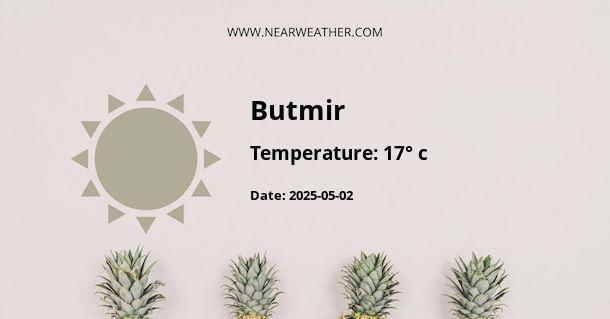Understanding the Climate and Weather of Butmir, Bosnia and Herzegovina
Butmir, located on the outskirts of Sarajevo, the capital city of Bosnia and Herzegovina, experiences a climate that showcases the diverse weather patterns characteristic of Southeastern Europe. This article will delve into the intricate climatic nuances of Butmir, providing an in-depth understanding of its seasonal variations and the meteorological influences that shape its weather year-round.
Geographical Influence on Butmir’s Climate
The climate of Butmir is influenced by its geographical position in the Balkan Peninsula. Nestled within a valley and surrounded by the Dinaric Alps, Butmir experiences a mix of Mediterranean and continental climatic elements. The complex topography results in microclimate areas, causing variations in weather patterns even within short distances.
Seasonal Weather Patterns in Butmir
Spring
Spring in Butmir signals a transition from the cold, snowy winters to more temperate conditions. The season sees a gradual increase in temperature and longer daylight hours, leading to the melting of winter snows and the blossoming of the valley’s abundant flora.
- Temperature: Average temperatures range from 6°C (42.8°F) to 20°C (68°F) with increasing warmth as summer approaches.
- Precipitation: Spring is known for its frequent rainfall, contributing to the region’s lush greenery.
Summer
Summer brings warmth and a fair share of sunny days, although the proximity to the mountains can introduce sudden weather changes, including thunderstorms.
- Temperature: Temperatures in summer typically range between 15°C (59°F) and 30°C (86°F).
- Precipitation: Despite the possibility of thunderstorms, summer is relatively dry, especially in July and August.
Autumn
Autumn is characterized by mild, comfortable temperatures during the day and cooler nights, with considerable precipitation that contributes to the picturesque changing of the leaves.
- Temperature: Average temperatures range from 5°C (41°F) to 20°C (68°F), gradually decreasing as winter approaches.
- Precipitation: Rain is common during the autumn months, with October often being the wettest month of the year.
Winter
Winters are chilly and snowy in Butmir due to its continental influences. It is a season of stark beauty as the surrounding mountain peaks glisten with snow.
- Temperature: The average winter temperature hovers around -2°C (28.4°F) to 3°C (37.4°F).
- Precipitation: Snowfall is common, particularly from December to February, providing a boon for winter sports enthusiasts.
Average Weather and Climate Metrics: An Annual Overview
| Month | Temperature range (°C) | Precipitation (mm) | Weather conditions |
|---|---|---|---|
| January | -4 to 2 | 72 | Coldest, often snowy |
| February | -3 to 4 | 65 | Cold, snow possible |
| March | 1 to 10 | 68 | Transitioning, wet |
| April | 5 to 15 | 71 | Warmer, rain showers |
| May | 10 to 20 | 86 | Moderate, increased rainfall |
| June | 13 to 24 | 90 | Warm, occasional thunderstorms |
| July | 15 to 27 | 74 | Warmest, relatively dry |
| August | 15 to 27 | 73 | Warm, possible heatwaves |
| September | 11 to 22 | 84 | Cooling down, increased precipitation |
| October | 6 to 16 | 91 | Autumnal, often rainy |
| November | 2 to 10 | 86 | Chilly, damp |
| December | -2 to 4 | 82 | Cold, snowy periods |
Climate Considerations for Visitors and Residents
When considering travel or activities in Butmir, it’s advised to keep a close eye on both short-term weather forecasts and seasonal climate expectations. Factors such as elevation, terrain, and prevailing winds can impact local weather significantly, often with little warning. Therefore, it’s prudent for visitors to be equipped with layered clothing to handle the variable conditions that Butmir's climate can offer.
Tourism and Seasonal Activities
Butmir's weather supports a range of activities throughout the year. Winters cater to skiing and other snow sports, while summers are ideal for hiking, exploring the cultural landmarks of Sarajevo, and enjoying the outdoor cafes and markets. Spring and autumn, with their temperate weather, are excellent times for sightseeing and exploring the natural beauty of the region.
Extreme Weather Patterns and Precautions
While Butmir enjoys a generally moderate climate, extreme weather conditions, such as heavy snowfall in winter and heatwaves in summer, do occur. During these times, it’s important for the local population and visitors alike to take necessary precautions—such as proper home heating, snow tires and chains in winter, and staying hydrated and out of the sun during heatwaves.
Consistent with Climate Change Trends
Climate change has an undeniable impact across the globe, and Butmir is no exception. Trends suggest that temperatures have been gradually increasing, with the possibility of more pronounced heatwaves in summer, and less predictable snowfall in winter. This affects not only the local ecosystem but also has implications for water resources, agriculture, and tourism in the area.
Conclusion
In summary, Butmir, Bosnia and Herzegovina presents a climate that is as varied as its historical and cultural heritage. The interplay of Mediterranean and continental climate influences gives rise to a weather personality that is rich and multifaceted, requiring due diligence from residents and visitors alike to navigate its seasonal extremes. With a clear understanding of the monthly weather patterns and a mindful eye on global climatic trends, one can fully appreciate and prepare for the atmospheric beauty of Butmir year-round.
A - Butmir's Latitude is 43.819172 & Longitude is 18.326111.
A - Weather in Butmir is 6° today.
A - Climate Conditions in Butmir shows scattered clouds today.
A - Humidity in Butmir is 61% today.
A - Wind speed in Butmir is 35.17 km/h, flowing at 140° wind direction. today.
